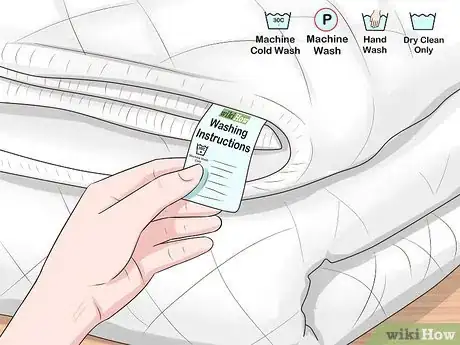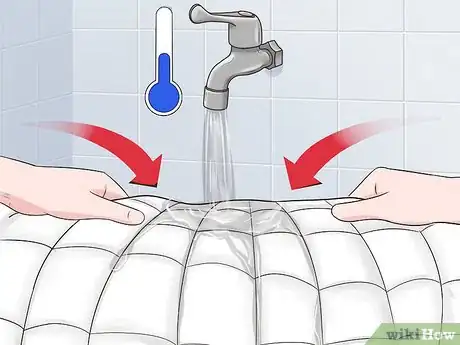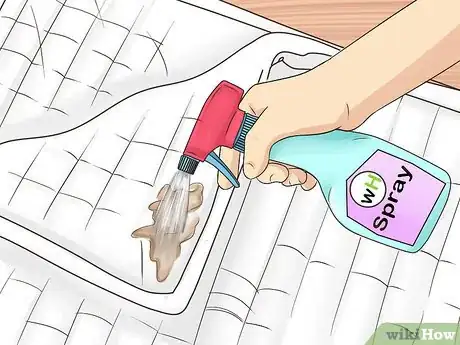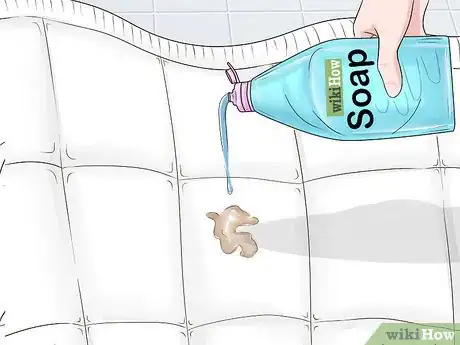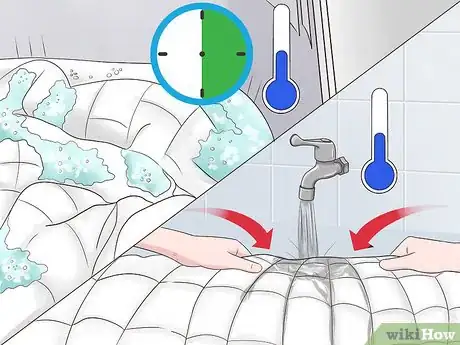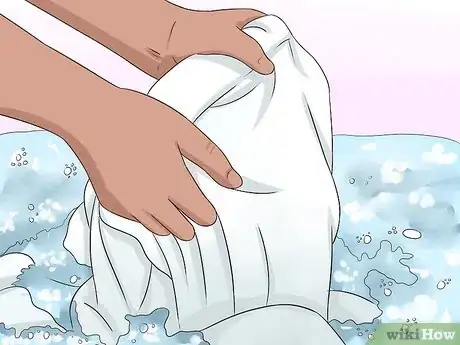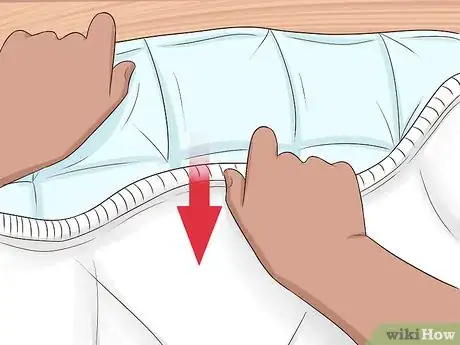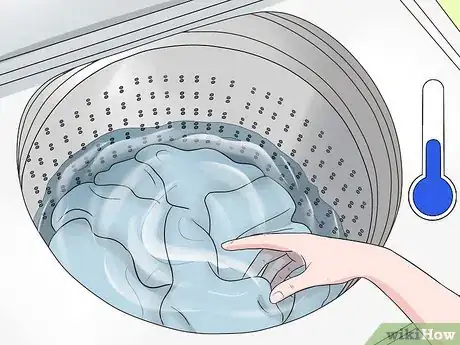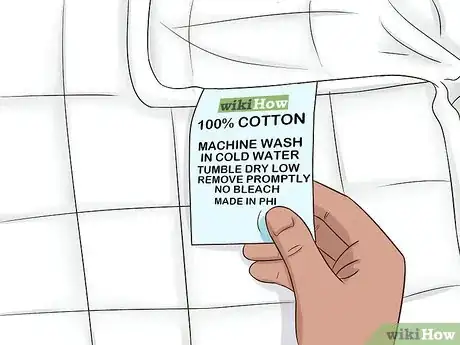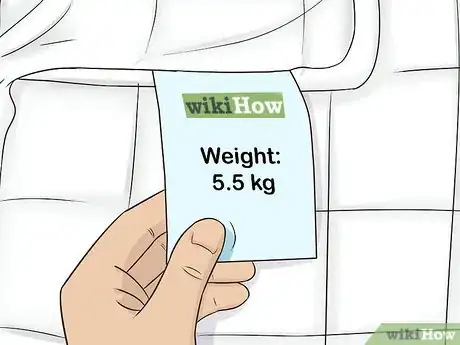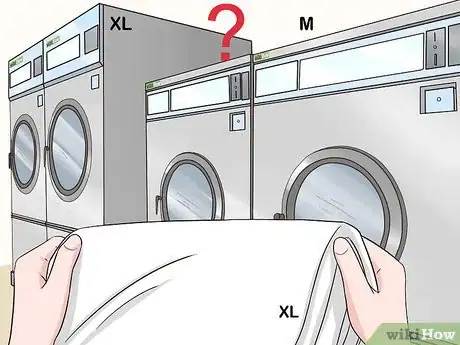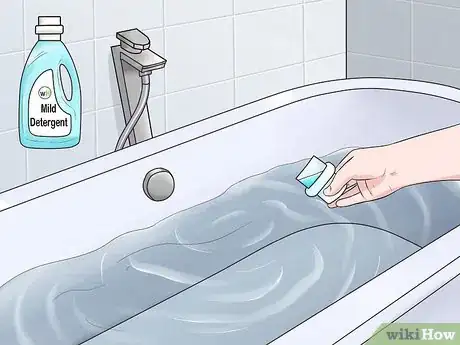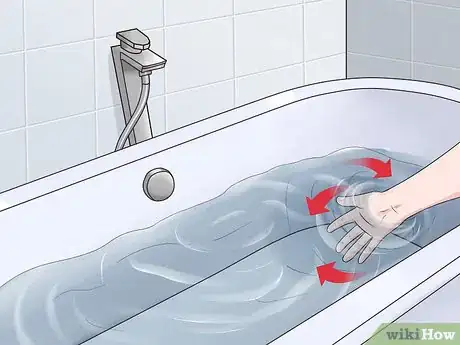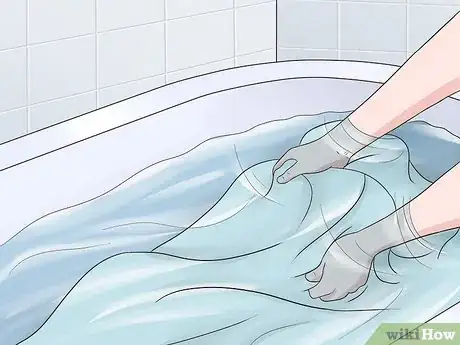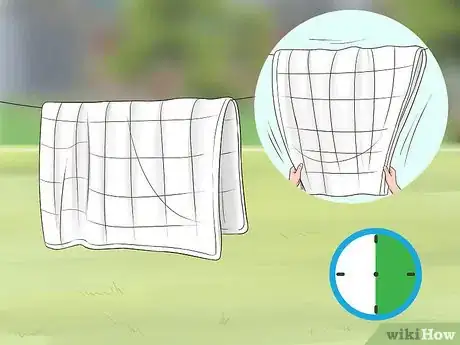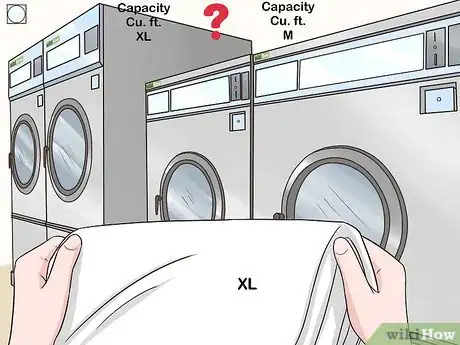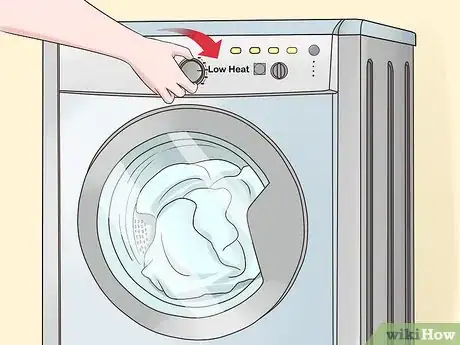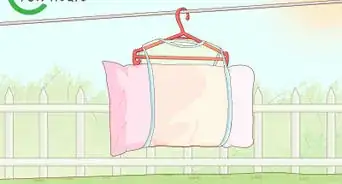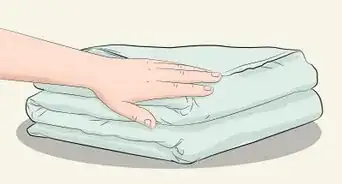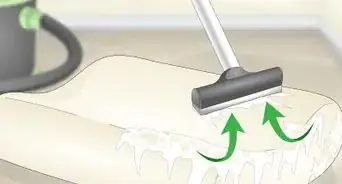This article was co-authored by Safir Ali. Safir Ali is the Co-Founder and CEO of Hamper Dry Cleaning and Laundry, a startup in Houston, Texas reinventing the laundry industry. With over six years of experience launching and operating Hamper, Safir specializes in innovative ways to simplify dry cleaning using the experience from his family's business. Safir holds a Bachelor’s degree in Business Administration and Management from Texas A&M University. Hamper offers 24/7 on-demand dry cleaning and laundry through delivery and kiosk services. Hamper has been featured on the Houston Rockets, Station Houston, the Houston Business Journal, BBVA, Yahoo Finance, and Innovation Map.
There are 12 references cited in this article, which can be found at the bottom of the page.
This article has been viewed 92,102 times.
Weighted blankets can be of great comfort to many people. These blankets can be of particular benefit to autistic people, people with anxiety and/or sensory disorders, and keeping them clean and fresh is best for optimum comfort. [1] Taking good care of your blanket will allow you to keep enjoying the comfort your blanket provides.The important part of taking care of your blanket is knowing what material it is made of, and washing it according to the fabric's needs or manufacturer's instructions. Cold water and gentle cleaning products can keep you holding on to them for longer with careful machine or hand washing.
Steps
Preparing a Weighted Blanket for Washing
-
1Read the cleaning instructions. Your blanket might have special instructions for treating or washing it.Tags on the blanket or instructions that came with purchase may tell you if there are special washing instructions for your particular brand. If it requires special care, the manufacturer may have indicated this.
- Check the material of your blanket. Gentle machine washes in cold water are generally advised for most blankets, but this can differ depending on the fabric of your blanket and its level of cleanliness.
- Some blankets have a removable outer layer. If yours does, it can be treated and washed separately. This layer will function like a duvet cover covering the inner weighted blanket and is easily removed.
-
2Inspect your blanket thoroughly. This is a good way of checking for any damage or stains that may require pre-treating before you wash the whole blanket. Treating your stains prior to washing can prevent them from being 'baked in' or set into the fabric of your blanket during the washing and drying process.
- If you can, treat your stains as soon as you spot them. This will prevent stains from setting into your blanket, and make them easier to clean.
- If the stain is an older one, you will treat it best if you know what kind of stain it is. Treatment will differ if the stain is from a food spill, body fluid, or other type of dirt.
Advertisement -
3Gather your blanket for rinsing. As soon as you spot the stain, expose the section of the blanket that has been stained. Hold this section under cold running water.
- You can do this whether your spot is wet or dry. Adding moisture to the stain can loosen the fibers of the blanket that might be matted down with dirt. Running water on it can cause the dirt on the surface of the stain to run off, especially if the spot is fresh.
- Angle the stained section away from you and downwards under the running water. This will prevent loosened dirt and water from running towards you or across the rest of the blanket. Try holding the rest of the blanket close to you and away from the faucet.
- It is important to use cold water because of your blanket's fabric and the stain itself. Most weighted blankets should only be washed in cool water, and hotter temperatures may cause the stain to set into the blanket's fibers.
-
4Treat liquids with spray treatments.[2] Beverages or protein-based stains like bodily fluids can be very common spills on household items. For these, use a spray that does not include harsh chemicals which can affect the soft material of your blanket.
- Many laundry products for stain removal can include bleach or other whitening agents. Avoid these and instead try a stain remover that is designed for the fabric of your blanket. It may be marketed towards use on rugs or throws, but should be appropriate if it is bleach-free, safe for your fabric, and hypoallergenic.[3]
- Place the stained section under cold running water as soon as you can. Hold only the stained spot under the water in order to prevent colored stains from running across the blanket. If the stain has gone through the material, lift it to see what is visible on either side. This will indicate how much treatment it needs.
- Choose your gentle stain remover and spray it liberally on the stain. Gently rub the treatment into the stain with your fingers or a very soft brush. If the stain is visible on the underside of the blanket, rub the treatment into the stain on both sides.
- Do not try to scrub it out by rubbing the fabric together, as this will only spread the stain. [4]
-
5Treat grease stains with soap. If you drop food or anything oil-based onto your blanket, use dish soap on the spot.[5] Again, avoid anything harsh or with bleach. Unscented, non-chlorinated dish soap is the best option.
- Once you have run water over it, directly apply the dish soap to the area of the stain. Target the site of the spot as much as possible.
- Rub the soap in gently with your fingers or a very soft brush. Try a clean, soft bristled laundry or tooth brush and very gently use upward rubbing motions to lift the grease.[6]
- It can be difficult to tell if a grease stain has been fully removed if it is colorless. Hold the stained section into the light in order to test if the grease stain has gone.[7] You can also run your fingers through long fibers and feel for any greasy residue.
-
6Rinse out the section you have treated. Run cold water over the cleaning agent and dirt so you can see how much of the stain is left to treat.
- Repeat the process with lightened applications of soap if the stain is still visible.
- Even if the stain is stubborn, avoid heavy scrubbing as this will set the stain into your blanket's fibers.
- Soak the blanket in cold water for 30 minutes if the stain is still visible.
-
7Wash your blanket straight away. Once you have finished pre-treatment and rinsing, wash your entire blanket according to instruction after you treat it. This will enable the best result for a clean blanket.
- If you cannot wash it straight away, keep the blanket in cold water until you can.
Washing a Removable Outer Layer
-
1Remove the outer layer. Your blanket may have an outer layer to protect the inner weighted material. It will be kept closed by a zipper or series of snaps. Undo these and carefully peel the outer layer from the blanket.
-
2Put the layer in the washing machine. Use a gentle or delicate cycle with cold water.
- Use a small amount of liquid detergent. This usually goes into the central slot of the detergent dispenser on a front loader. Avoid bleach or whitening agents.
- Depending on its size or thickness, the cover may need to be washed by itself. Alternatively, you can wash it with a few towels to keep the washer balanced.
- If this is a first wash or the cover has bright colours that run, wash the cover separately in a cold, gentle machine wash with 1 cup of salt to set the colours.[8]
-
3Tumble dry this layer on low heat. Set your dryer to low heat or air fluff. To avoid crumpling, remove the layer from the dryer before it has finished drying and hang it out to complete the drying process.
Machine Washing a Weighted Blanket
-
1Check the fabric your blanket is made of. If the blanket does not have an outer layer, or you are washing the inner, it is important you know what it is made of. Washing instructions can differ for blankets of different materials.
-
2Check the size and weight of your blanket. Blankets that weigh more than 12lbs (5.5kg) should be washed in a commercial washer with the capacity for large loads.[9] Check what your washing machine's weight capacity is too.
- If your blanket is too heavy for your washer's recommended load, you can take it to a laundromat or a professional laundering service with large commercial machines.
- If you are using a professional service, ensure the blanket is washed according to the right temperature for your blanket's fabric. Make sure you do not dry clean your blanket.[10]
-
3Put your blanket in the appropriate sized washer. Select either a cold or warm water cycle depending on the fabric. Choose the lightest wash setting, either a gentle or delicate setting on your washer. Use a gentle detergent that does not include any bleach or whitening agents.[11]
- Soft fleece blankets (also called cuddle fleece or 'Minky', of a soft plush feel) should be washed in a cold water machine wash with a gentle detergent. Avoid fabric softener which can gel the short, soft fibers.[12]
- Ultra-soft chenille blankets can be washed in a cold or tepid water machine cycle with gentle detergent.
- Poly-pellets or bead inner blankets can be washed in a warm water cycle, but avoid hot water.
- 100% cotton-inner blankets can use either cold or warm water alone in a delicate machine cycle with gentle detergent.[13]
- Wash waterproof blankets in a warm or hot water machine wash as these can be harder to clean. Still avoid bleach or vinegar cleaning products.[14]
- If you have a flannel blanket, use fabric softener in a cold or medium water cycle. Alternatively, put 1 cup of white vinegar in the rinse water. Doing either of these will soften the flannel and remove pilling (the bumpy threads that break and clump on the surface of the material).
Hand Washing a Weighted Blanket
-
1Fill a tub halfway with tepid water. This can be a clean bathtub or large laundry basin. Make sure it is big enough for your blanket and required volume of water.
- Don't fill up the tub too much. You will want room to be able to move the blanket in the tub without spilling water over the tub.
- Have the tub at an appropriate height if you have trouble bending over. Avoid leaning over a tub if the blanket will be too heavy for you to lift when wet.
-
2Add a mild detergent to the water. Avoid harsh chemicals which can damage the fibers of the fabric and cotton filling. This includes bleach or other whitening agents.
- Gentle detergents and thoroughly rinsing your blankets and covers keeps the fabric soft and comfortable on your skin.
- Use an amount of detergent suitable for the size of your blanket. Between half to a full single cupful (the cup of your detergent container) should be adequate.
-
3Run your hands through the water. Use a sloshing motion to activate the detergent in the water, making it frothy. This evenly spreads the detergent throughout the tub, giving your blanket even soap coverage when washing it.
-
4Submerge the blanket completely in the water. Push the blanket into the water to completely cover it in the soapy water. Use your hands to gently knead the blanket in sections so you know where you have cleaned. Leave the blanket in the tub and drain the water from the tub.
-
5Pour fresh water into the tub. Once the original soapy water has drained, add clean water and rinse the blanket. Do this repeatedly until there is no soap residue left on the blanket.
- Swishing the blanket through the clean water will help dispel the soap from your blanket.
- You will know if the soap has been removed when the rinsing water runs clear.
-
6Remove the excess water. Squeeze out the excess water from the blanket by rolling it tightly. You don't need to wring it out. Do this repeatedly until most of the water has been dispelled.
- You can roll or fold the blanket and press on it to squeeze out the water.
- You will not be able to get all the water from the blanket, which is normal.
- Wringing out your blanket could misshape or redistribute its weight, so squeezing is the best option.
-
7Dry the blanket. Lay it out in the sun or over a banister. Shake it out every 30 minutes to shake out excess water and redistribute the weight.[15]
- These blankets are designed to provide additional levels of comfort via evenly distributed weight and gentle pressure, so keep them as even as possible.[16]
Drying a Weighted Blanket
-
1Ensure your dryer has the capacity and size to dry your blanket. Your blanket can be much heavier when wet. Some household dryers may be too small for the size and weight of your blanket.
-
2Use a low heat or air fluff setting. If you are machine drying, choose lower heat settings. Throw in a clean towel to help fluff your blanket up while it is drying.[17]
- Low heat is best for fleece, cotton, and chenille blankets. High heat can shorten the fibers of chenille over time.
- Poly-pellet blankets can be dried and warmed safely in low or medium heat dryer settings.
- Dry waterproof blankets on a low heat setting even if warm or hot water has been used to wash a stubborn blanket.
-
3Lay out your blanket. If you are air drying your blanket, exercise caution. Avoid hanging the blanket to dry. If the weight of the blanket is pulled to one side, this negates the even weight distribution within the blanket, stretches the material, and can ruin the blanket.
- Try laying it out or across open, ventilated surfaces like a banister.
- Shake it out regularly to ensure the weight hasn't redistributed unevenly.[18]
Community Q&A
-
QuestionWhy does my weighted blanket smell bad?
 wikiHow Staff EditorThis answer was written by one of our trained team of researchers who validated it for accuracy and comprehensiveness.
wikiHow Staff EditorThis answer was written by one of our trained team of researchers who validated it for accuracy and comprehensiveness.
Staff Answer wikiHow Staff EditorStaff AnswerSome weighted blankets have a strong plastic odor due to the types of weights they’re made with. Getting a blanket weighted with glass beads can help you avoid this problem. Over time, your blanket might get a musty smell due to humidity or body odor, in which case washing it or letting it air out in the sun for a while can help.
wikiHow Staff EditorStaff AnswerSome weighted blankets have a strong plastic odor due to the types of weights they’re made with. Getting a blanket weighted with glass beads can help you avoid this problem. Over time, your blanket might get a musty smell due to humidity or body odor, in which case washing it or letting it air out in the sun for a while can help. -
QuestionHow often should you wash a weighted blanket?
 wikiHow Staff EditorThis answer was written by one of our trained team of researchers who validated it for accuracy and comprehensiveness.
wikiHow Staff EditorThis answer was written by one of our trained team of researchers who validated it for accuracy and comprehensiveness.
Staff Answer wikiHow Staff EditorStaff AnswerUsually, washing a weighted blanket 3-4 times a year is enough. However, if you frequently sleep under it and it starts to develop a musty smell, or if it gets stained with urine or other bodily fluids, it may need more frequent washing.
wikiHow Staff EditorStaff AnswerUsually, washing a weighted blanket 3-4 times a year is enough. However, if you frequently sleep under it and it starts to develop a musty smell, or if it gets stained with urine or other bodily fluids, it may need more frequent washing. -
QuestionHow often should you replace a weighted blanket?
 wikiHow Staff EditorThis answer was written by one of our trained team of researchers who validated it for accuracy and comprehensiveness.
wikiHow Staff EditorThis answer was written by one of our trained team of researchers who validated it for accuracy and comprehensiveness.
Staff Answer wikiHow Staff EditorStaff AnswerWith good care, most weighted blankets last about 5 years. You may need to replace it more often if you have to wash it frequently.
wikiHow Staff EditorStaff AnswerWith good care, most weighted blankets last about 5 years. You may need to replace it more often if you have to wash it frequently.
Warnings
- Wash weighted blankets separately to prevent other items from potentially catching onto and tearing the blanket in a machine wash.⧼thumbs_response⧽
- If you have a top loader washer with an agitator, it is not recommended that you use it to wash a blanket with a weight over 10lbs (4.5kg) as the weight could throw the machine out of balance.[19]⧼thumbs_response⧽
- Do not iron, dry clean, or microwave your blankets. It is not recommended that your blanket undergo heat treatment. Heat, including hot water, can shrink soft threads or melt plastic pellets.⧼thumbs_response⧽
References
- ↑ https://www.forbes.com/sites/davidhochman/2014/04/25/weighted-blanket-can-help-more-than-just-sleep-problems/#29af8d23e0c9
- ↑ Safir Ali. Professional Dry Cleaner. Expert Interview. 15 September 2020.
- ↑ https://www.thelaundress.com/clean-talk-blog/how-to-care-for-wool-rugs-blankets.html
- ↑ https://www.mamaslaundrytalk.com/how-to-pre-treat-a-stain-on-clothing/
- ↑ Safir Ali. Professional Dry Cleaner. Expert Interview. 15 September 2020.
- ↑ https://www.pgeveryday.com/home/cleaning/article/13-stubborn-stains-and-how-to-remove-them
- ↑ https://www.mamaslaundrytalk.com/stain-removal-how-to-remove-food-grease-stains/
- ↑ https://www.sensacalm.com/pages/faqs
- ↑ https://www.mosaicweightedblankets.com/blanket-care/
- ↑ https://www.mosaicweightedblankets.com/blanket-care/
- ↑ https://www.sensacalm.com/pages/faqs
- ↑ https://harkla.co/blogs/special-needs/how-to-wash-a-weighted-blanket
- ↑ https://www.sensacalm.com/pages/faqs
- ↑ https://www.sensacalm.com/pages/faqs
- ↑ https://www.mycalmblanket.com/pages/how-to-clean
- ↑ https://www.medicalnewstoday.com/articles/317037.php
- ↑ https://www.mosaicweightedblankets.com/blanket-care/
- ↑ https://www.sensorygoods.com/v/vspfiles/files/washing_instructions_back.pdf
- ↑ https://www.sensacalm.com/pages/faqs
About This Article
If you want to wash your weighted blanket, check the care label and follow its advice. In general, blankets should be washed on a gentle cycle using cold water. If your blanket has a separate outer cover, you can remove it and wash it separately without washing the actual blanket. You can also wash a weighted blanket by hand in a tub using a mild detergent. Let your blanket air dry, or use a low setting on your drier to avoid crumpling. For tips on how to hand wash a weighted blanket, read on!
